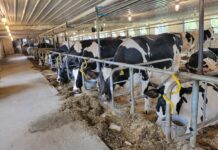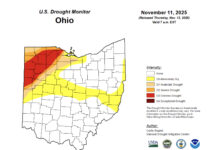You often pay attention to the milk components when you get your milk check, but they also serve as a window into the rumen health and metabolic balance of your cows.
The components in milk are primarily water, lactose, fat, protein, minerals, and vitamins (ranked in descending order of concentration generally found in milk). The concentration of lactose in milk (generally about 4.85 percent) is low in variability, and lactose is the primary regulator of milk volume. In milk pricing, it is often lumped into the other solids or solids-not-fat concentrations in milk. For management purposes, the concentrations of fat, protein, and urea in milk are monitored. The variation in concentration of protein in milk is considerably less than for milk fat (Table 1). For the Holstein breed, the variation in milk fat is about 2.7 times greater than for milk protein.On your milk check
Milk fat and protein are very important in the pricing of milk for payment to dairy farmers. Generally for most milk markets, but not all, the price for protein is higher than the price for fat.
The pricing of milk is based on the mass of the components, not proportions. Of course, fat concentration varies by breed, with Brown Swiss, Guernsey, and Jersey having the highest concentrations of fat and protein among the five major dairy breeds. However, it is interesting to note that milk from Brown Swiss cows is less variable in fat concentration than milk from the other four major breeds, with the variation being only 60 percent of the variation in fat concentration of Holstein herds. However, the variation in concentration of milk fat is about the same for the Holstein and Jersey breeds, the two most prominent breeds and differing in about one percentage unit in milk fat. The variation in milk composition is almost two-fold higher for individual cow versus herd data.Herd health
Besides the economic importance of monitoring milk fat concentration and yield, milk fat serves as an indicator for rumen health and metabolic balance of cows, especially ketosis.
Although milk fat concentration relative to the expected breed average sheds some evidence on animal health, the MF:MP is used more typically as an indicator of rumen heath. The ratio of 1.2 to 1.3 is expected (Table 1). A low milk fat or MF:MP may result from feeding diets without adequate concentration of fiber, particle size of forage is too short, rate of fermentation of the starch is too fast (e.g. dry versus high moisture corn), or cows may be sorting through feed for grain. A high concentration of fat may reflect feeding high dietary concentrations of fiber or low milk yield. Low concentrations of milk protein may reflect the feeding of diets low in protein, thus reflective of an inadequate supply of amino acids to the udder. Average herd milk fat and protein concentrations above the breed average also may be reflective of genetic selections based on milk fat and protein.Group variations
Monitoring milk fat and protein, or their ratio, is more valuable for animal groups within a herd than the overall herd. The ratio for the herd may be normal, but the ratio for a given group within a herd may be low or inverted.
The average ratio for a herd or a group within a herd is expected to be within the stated range; however, 10 to 20 percent of the cows within a group may have inverted MF:MP without there being dietary conditions adversely affecting rumen health. The concentration of fat in milk is much higher in early lactation than later stages, primarily due to the mobilization of body fat following parturition.Indicates ketosis risk
Because of the effect of days in milk (DIM) on milk fat concentration, milk fat can be monitored as an indicator of the risk for ketosis.
Optimizing the yield of milk fat and protein is important for the profitability of dairy farms. It is generally regarded that milk fat concentration should not exceed one unit above the breed average during the first 30 DIM and then not fall by more than one unit from 30 to 60 DIM. During 30 to 90 DIM, milk fat concentration should continue to drop whereby it would be similar to the breed average by more than 90 DIM. Establish a baseline. Milk urea nitrogen (MUN) concentration typically ranges from 10 to 14 mg/dl. It should be monitored for one to two months to establish a baseline for a herd and then management decisions can be made when shifts in concentrations occur. Low concentrations (< 9 mg/dl) of MUN sometimes reflect inadequate feeding of protein or over feeding of rumen undegradable protein. High concentrations of MUN (> 15 mg/dl) may indicate overfeeding protein, especially rumen degradable protein, or feeding diets too low in starch or nonfiber carbohydrates whereby the microbial activity in the rumen is comprised. Low MUN may indicate that the animals’ productive ability is being limited, and high MUN may indicate excessive feed costs from overfeeding protein, increased nitrogen (N) excretion which has implications for land application of the manure, and possibly may have an impact on embryo survival in pregnant cows. Milk yield, time of sampling relative to feeding, and season can affect concentrations of MUN. With fine-tuning of rations today for protein, low MUN can be achieved without adversely affecting milk yield and yet provide for lowering of N excretion. Optimizing the yield of milk fat and protein is important for the profitability of dairy farms. Monitoring milk fat concentration (along with MF:MP) is important for management of the risk of ketosis and rumen acidosis. The concentration of fat in milk is quite variable, but this variation can be greater within a milking and day than between cows within a herd and the day-to-day variation for a given herd. Changes in the concentrations of milk fat, milk protein, or MUN, or the MF:MP, can elicit actions by herd managers that can result in increased farm profitability and less risk of disease. (The author is a professor and Extension dairy specialist at Ohio State University.)












